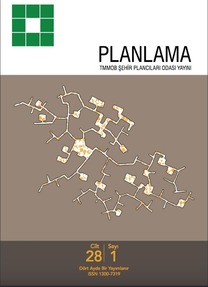Kentsel Mekanın Değişimi ve Gelişme Döngüleri; Eski Keresteciler Çarşısı (İzmir) Örneği
Kentler, kuruldukları günden itibaren politik, coğrafi, beşerî, eko- nomik değişkenlerin etkisiyle biçimlenen dinamik oluşumlardır. Gelişen bilgi ve teknolojinin sağladığı imkanlarla, modern üslup ve biçimlerde şekillenen tasarımların kentsel alanlarda görülmeye baş- laması, kentlerin dinamik yapısına daha da hız kazandırmıştır. Ancak mevcut kentsel doku ve yapılaşma biçimlerinden bağımsız olarak üretilen bu tasarımlar sonucunda, kentsel çevrelerin özgün ögeleri kaybolmaya, yeni üretilen kent parçaları aynılaşmaya ve standart- laşmaya başlamıştır. Buna rağmen insan ve doğal çevrenin etkile- şiminden meydana gelen kentler, farklı toplumsal ihtiyaçlar ve bu ihtiyaçların gerektirdiği mekânsal organizasyonlar sonucunda farklı- laşmaktadır. Kentsel mekânın biçimlenmesinde en önemli değişken olan kullanıcının, sahip olduğu değerleri kentsel dokuya aktarması ve özgün ögeler kazandırması ise tarihsel bir sürecin sonucudur. Bu bağlamda kent dokusunun hangi süreçlerden geçerek farklı- laştığı ve bu süreçlerin nasıl bir çözümleme ile ortaya koyulacağı sorusu ortaya çıkmaktadır. Kentsel karakterin tanımı ve tarihselliği üzerine teorik ve metodolojik bir çerçeve sunmayı amaçlayan bu çalışmada, kentsel mekânın değişimi tartışılacaktır. Çalışmanın yön- tem bölümünde kentsel mekânın değişim süreçlerini analiz etmeyi sağlayan kentsel morfoloji bilimi ve Conzen tarafından geliştirilen “gelişme döngüleri” ele alınacaktır. Şehirlerde farklı dönemlere ait özgün değerlerin görüldüğü ve tarihsel bir sürecin ürünü olan en önemli alanlar olan tarihi kent merkezleri, araştırmanın teorik çer- çevesi açısından önemlidir. Eski Keresteciler Çarşısı (İzmir) örnek alanında gerçekleştirilen bu çalışmanın, benzer alanlarda yürütüle- cek araştırmalar için yol gösterici olması amaçlanmaktadır
Change of Urben Space and Redevelopment Cycle; Eski Keresteciler Carsisi (Izmir) Case Study
Cities are dynamic formations that have been formed by the ef- fects of political, geographical, human and economic variables. The appearance of designs shaped by the developing informa- tion and technology in modern styles and forms in urban ar- eas has accelerated the dynamic structure of cities even more. However, as a result of these designs which are produced inde- pendently of the existing urban forms, the original elements of the urban environments have started to disappear. Neverthe- less, cities, which are formed by the interaction between hu- man and natural environment, differ as a result of different so- cial needs and the spatial organizations. The user transfers his/ her values to the space and gains original elements in historical process. In this context, the question of which processes the urban fabric differs through and how these processes will be presented emerges. In this study, which aims to present a the- oretical and methodological framework on the definition and historicity of urban character, the change of urban space will be discussed. In the methodology section of the research, urban morphology which enables to analyze the formation processes of urban space, and the "redevelopment cycle" developed by Conzen will be discussed. Historic city centers, which are the most important areas where unique values of different periods are observed in cities and the products of a historical process, are important in terms of the theoretical framework of the research. This study, which is carried out in Eski Keresteciler Çarşısı (Izmir), is intended to be a guide for researchers in similar studies.
___
- Alexander, C. (1965). City Is Not A Tree. Architectural Forum, 58-62.
- Arkon, H. (1978). Tarihi Kent Merkezinde Koruma Planlaması; İzmir Örne- ği Yüksek Lisans Tezi. İzmir.
- Beyru, R. (2011). 19. Yüzyılda İzmir Kenti. Literatür Yayıncılık.
- Conzen, M. (1960). Alnwick, Northumberland: A Study in Town-plan Analysis. London: Orge Philip & Son Ltd.
- Conzen, M. (1966). Historical Townscapes in Britain, A Problem in Applied Geography. Northern Geographical Essays, 56-78.
- Conzen, M. (1975). Geography and Townscape Conservation. Giessener Ge- ographische Schriften, Special Volume, 95-102.
- Conzen, M. (1988). Morphogenesis, Morphological Regions and Secular Hu- man Agency in The Historic Townscape as Examplified by Lodlow. G. S. Dietrich Denecke içinde, Urban historical geography: recent progress in Britain and Germany (s. 116-142). Cambridge: Cambridge University Press.
- Cullen, G. (1961). Townscape. New York: Reinhold Publishing Corporation.
- Friedmann, J. (2010). Place and Place-Making in Cities: A Global Perspective. Planning Theory and Practice 11(2), 149-165.
- Jacobs, J. (1961). The Death and Life of Great American Cities. Random Ho- use.
- Kropf, K. (1996). Urban Tissue and Character of Towns. Urban Design In- ternational, 1(3), 247-263.
- Kropf, K. (2014). Ambiguity in the Definition of Urban Form. Journal of Ur- ban Morphology, 18(1), 41-57.
- Lynch, K. (1960). The Image of The City. Massachusetts Institute of Techno- logy & Harvard Collage.
- Norberg-Schulz, C. (1979). Genius Loci: Towards a Phonomology of Archi- tecture. New York: Rizzoli Internetional Publications.
- Rossi, A. (1984). The Architecture of The City. Cambridge: The MIT Press.
- Schlebusch, S. (2015). Planning for Sustainable Communities: Evaluating Place-Making Approaches. Architecture, Forestry and Fisheries Journal 4(4-1), 59-72.
- Tuna, N. (1970). Kemeraltı Tarihsel Kentsel Sit Alanı Arazi Kullanış Haritası 1/1000.
- (2007). Urban Design Compendium. English Partnerships / The Housing Corporation / Llewelyn-Davies.
- (2017). İzmir Tarih Projesi Tasarım Stratejisi Raporu. İzmir: İzmir Büyük- şehir Belediyesi.
- Whitehand, J. (1981). The Urban Landscape: Historical Development and Management Papers By M.R.G. Conzen. London: Academic Press INC. (London) LTD
- ISSN: 1300-7319
- Yayın Aralığı: Yılda 3 Sayı
- Başlangıç: 1986
- Yayıncı: TMMOB Şehir Plancıları Odası
Sayıdaki Diğer Makaleler
Direnişçi Planlama: Gelişmekte Olan Ülkeler İçin Yeni Bir Planlama Kuramı
Türkiye’nin Otopark Politikasında Paradigma Değişimi İçin İki Öneri
Emine Yetişkul Şenbil, Metin Şenbil
Kentsel Mekanın Sosyallik Durumları Üzerine Biçim Odaklı Bir Bakış
Kentsel Mekanın Değişimi ve Gelişme Döngüleri; Eski Keresteciler Çarşısı (İzmir) Örneği
Neslihan Karataş, Mehmet Ali Kaya
Fatma Şenol, Sevim Pelin Öztürk
1999 Depremlerinin Ardından Planlama Mevzuatı Üzerine Bir Değerlendirme
The Effect of Changes in Coastal Law on Land Use Change in Coastal Settlements: Kuşadası Center Case
Neriman Yörür, Ayşegül Altınörs Çırak, Sibel Ecemiş Kılıç, Rana Başak Serim, Neslihan Karataş
